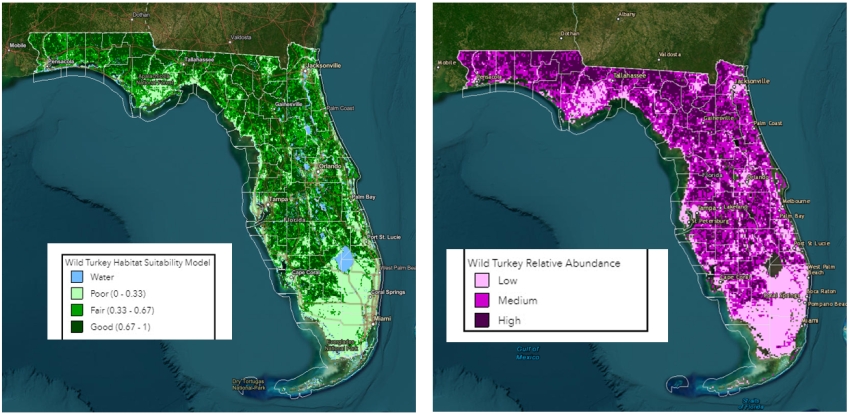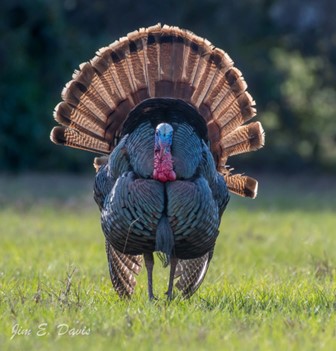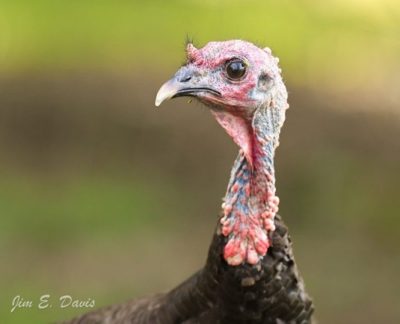Samantha Wisely, Professor and Extension Specialist of Wildlife Ecology
Fortunately for Panhandle residents, turkeys are a common site. Although turkey populations have declined throughout the United States, the decline is less dramatic in Florida. The Panhandle of Florida contains some of the best habitat for wild turkeys in the state and as a result has some of the highest population estimates (Figure 1).

Figure 1. Wild Turkey habitat suitability model (left) and wild turkey relative abundance (right) in Florida. Florida Fish & Wildlife Conservation Commission (FWC) Division of Hunting and Game Management and the FWC Fish and Wildlife Research Institute Center for Spatial Analysis. Original Habitat Suitability Model created by Holly N. Morris.
–
Habitat change, mostly development, is the largest threat to Florida turkey populations, but poor habitat management can also contribute to lower productivity. Turkeys like patchy habitats dominated by open deciduous forests intermixed with small patches (1 to 20 acres) of open grassy areas. Prescribed fire at regular intervals maintains the open understory that is essential for turkeys to see and avoid predators. Turkeys are attracted to recently burned areas and the regenerative growth is also essential for food and cover for growing young (poults). Poults exclusively eat insects, so plant species that attract insects promote poult growth. The ideal grassy habitat patch for hens with her poults should be about chin height and composed of grass, wildflowers and forbs that is not too dense at the ground; therefore, sod forming grasses such Bahiagrass, Bermudagrass or annual ryegrass, which are very dense at ground height, are not particularly good for turkey. Food plots designed for turkeys should avoid these types of grasses in the mix.
Turkeys are one of the most popular game species in Florida and 85% of the turkey harvest occurs on private lands. Private landowners that use prescribed fire and create habitat for growing poults are an essential part of turkey conservation. Conservation for turkeys on public land is largely funded by hunters who must purchase a turkey stamp. Those funds go directly to back to turkey management and habitat improvements on public land.
The Wild Turkey Summer Survey is a crucial tool used by wildlife managers at Florida Fish & Wildlife Conservation Commission to set harvest limits and to assess habitat management needs. The survey runs from June 1 to August 31 each year with the goal of determining the population status of turkeys in different regions of the state and provides data on population health. The survey relies on citizen participation. In 2022, the last year for which data is publicly available, over 3,400 observations were reported on 16,456 wild turkeys that were observed in 66 of the 67 counties (none from Monroe County). Northwest Florida had the highest productivity in the state in 2022 (Table 1).

Table 1.Data from the 2022 Wild Turkey Summer Survey Summary provided estimates, which are the average value in a given region of Florida. Poults per hen and poults per brood provide a good indication of reproductive success. Percentage of hens observed with poults indicates nesting success, and the number of females per male provides a relative measure of gobblers surviving from the previous spring turkey hunting season.
–
The bountiful wild turkey observed in Panhandle are a product of good land stewardship in the region. Frequent prescribed fire and food plots that keep turkey poults in mind will help to keep them plentiful.
If you want to learn more about wild turkey biology and management in Florida and beyond, check out the podcast, Wild Turkey Science. This is a science-based podcast bringing you the latest research on wild turkey ecology and management. It is hosted by Dr. Marcus Lashley at the University of Florida and Dr. Will Gulsby at Auburn University, and made possible by Turkeys for Tomorrow and is part of the Natural Resources University podcast network. The purpose of the podcast is to serve as a hub for research on wild turkeys and how it can be applied to conservation and management on private and public lands. Episodes are released every Monday 7:00 AM (EST) and available across all major podcasting platforms. A few weeks ago, Wild Turkey Science released a survey to gather listener information and measure impact of extension efforts. The amount of impacted land from their listeners totaled 1,809,239 acres.
Wild Turkey Science Libsyn Podcast Page
Wild Turkey Science YouTube Playlist
@DrDisturbance – Instagram – X formerly Twitter
@ufdeerlab – Instagram – Facebook – YouTube – X formerly Twitter
- Armadillo Biology, Management, and Disease in the Panhandle - February 21, 2025
- Crop Damage from Deer in the Panhandle - August 15, 2024
- Status Update on Wild Turkeys in the Panhandle - February 23, 2024


